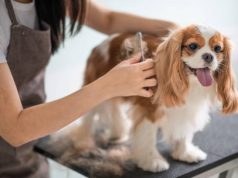Cats make loving and playful pets and thrive best when their dietary, environmental and health needs are cared for.
Amongst all the domestic pets, cats have the reputation of being the most independent and least demanding of your time.
However, as a good cat parent, you need to make sure that you groom and care for your kitty just as much as you would any other animal.

Grooming Tips
- Brushing
Your cat loves nothing more than a soothing back rub, and you can use this back-rub time to give it a thorough brushing with a bristle or rubber brush created for the purpose. It helps detangle the fur, removes dirt, spreads natural oils throughout the body, and keeps the skin clean of any irritants.
- Bathing
Yes, we understand your cat’s aversion towards the water. Then again, when your cat becomes greasy, smelly, or oily, it needs a bath, and it is your responsibility as a cat parent to wash it. Ensure that you use a shampoo that is meant for cats.
For bathing your cat, begin with dry brushing to remove all the debris from its fur, followed by a gentle shower in the sink or tub. Now you can use a large towel to pat your cat dry.
- Clipping your cat’s nails
The first rule to DIY nail clipping with cat clippers is to check your kitty’s paws for claw growth regularly. This will not only ensure that you know when to perform the job, but will ensure your cat is used to having its paws touched, a part of their body that is often ignored by pet owners.
Rub your cat’s paws frequently; press their toes, and praise them for accepting it. It might take a week or two, but your cat will eventually become accustomed to this and will allow you to trim its nails without making much fuss. If you are not confident trimming your cat’s nails yourself, then have a professional do it for you.
Check your Cat’s Overall Health Yourself
Whenever your cat hops on your lap for a scratch, make sure that every once in a while, you divert your attention from cuddles to its well-being. Perform a thorough check to see how it is doing, and if you notice anything unusual, then take it to the vet. However, do not altogether substitute your DIY checks for those of a vet’s. Get into the habit of taking your cat to the vets annually, or every six months for older felines.
Here are the aspects you need to pay attention to when checking your cat:
- Eyes
Make sure that your cat’s eyes are bright, clear, and they do not have any pigmentation or redness. If you see any, it could be a sign of infection which requires you to visit the vet immediately.
- Claws
Even though cats are gentle creatures, your house upholstery might not stay immune to its sharp claws for long. Therefore, it is sensible to keep cat clippers handy or visit a cat salon whenever you find your indoor cat’s claws overgrown.
- Ears
If you see your cat scratching its ears, check them for ear mites. Although ear mites are not visible, they leave a brown muddy discharge in the ear, helping you detect them.
Also, regularly check your cat’s ears for wax build-up, debris, dirt, sores, discharge, and any other sort of inflammation. While, as in human ears, some wax is regular, the ears should not emit too much or have an odour. Trust your intuition and if you feel that there is something wrong with your cat’s ears, visit the vet straight away.
- Nose
Your cat loves to get its nose scratched, but even its nose can develop infections. So, if you find the generally moist and smooth nose of your cat bumpy, lumpy, or otherwise not quite right, it needs your attention. If it is releasing a discharge, this is a sign of infection and requires a vet’s attention immediately.
- Mouth, Teeth, and Gums
The oral health of your feline is as vital as that of a child. Therefore, you need to make sure that its teeth are clean, white, and healthy. The gums should be free from any soreness or swelling. If there is any redness or inflammation on the naturally pink and smooth gums of your cat, then it is essential to visit the vet.
Also, try to check the back of your cat’s mouth for any ulceration, lumps, or bumps. It should be free from all of those and there should be no foul odour coming from the mouth or gums.
To prevent infections, make sure that you brush your cat’s teeth regularly and look after its oral well-being.
- Breathing
Check your cat’s breathing is easy. Take note of whether your cat is breathing effortlessly or whether it is laboured at all. If your cat is often running short of breath or is breathing erratically, then you need to visit your vet for a thorough check-up.

- Coat and Skin
Your cat is vulnerable to more than just infections, as cats can develop severe stress disorders too. You can detect a stressed cat by noticing if it gets irritated easily, or if your cat licks, chews or scratches themself more often than they used to.
Your cat can get affected by parasites and allergies which needs to be checked by a vet too.
- Body and Mobility
Keep checking your cat’s body regularly for any uneven bumps, lumps, or swellings. Make sure that your cat is effortlessly jumping on and off furniture like it used to with agility. If not, check for stress, pain, or tension in its muscles. If their limbs feel stiff, take a visit to the vet.
Aside from the above, try to keep track of your cat’s daily routine and activities. Whenever your cat is doing something out of character or strange that it has never done before, assume there might be a reason for it and investigate to be on the safe side. Even if it is something as seemingly insignificant as sitting in a place in the house that it never used to.
No two cats are the same so it’s important that you take the time to really get to know your cat and what their normal behaviour is so that you can easily identify anything that isn’t normal.














